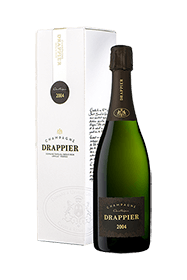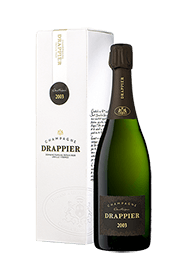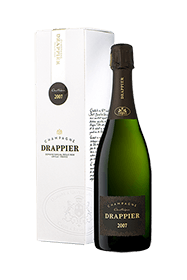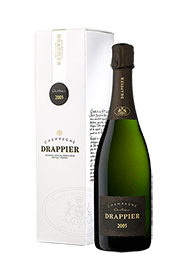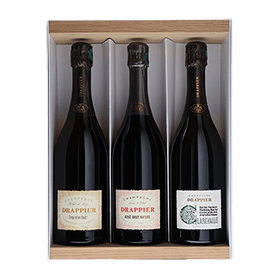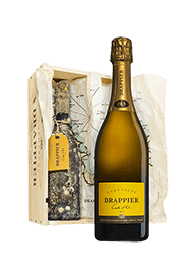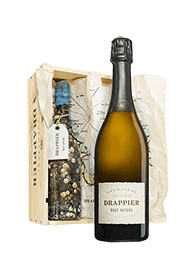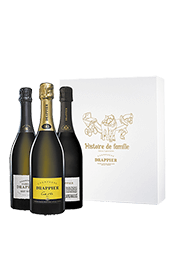Since 1808, Maison Drappier has embodied the winemaking excellence of the Côte des Bar, where Pinot Noir reigns supreme. Established in Urville, a village whose winegrowing history dates back to the Gallo-Roman era, this family estate preserves know-how passed down through eight generations. The prestigious House cultivates a rarity today: the authenticity of a winegrowing family that owns and works its 55 hectares of vines itself. This independence gives them the freedom to express a distinctive vision in which tradition and character blend in perfect harmony.
Characterful champagnes driven by Pinot Noir
Drappier’s champagnes stand out for their powerful structure and aromatic depth, the fruit of a vineyard planted 75% to Pinot Noir. The House complements this base with Chardonnay, Pinot Meunier, and forgotten varieties such as Arbane, Petit Meslier, and Fromenteau.
Carte d’Or, the emblem with the yellow label
Created in 1949, the Carte d’Or cuvée remains the estate’s signature. Its Pinot Noir-dominant blend gives it a golden hue with copper highlights and an expressive nose of ripe yellow fruit, buttery brioche, and spicy notes. On the palate, the attack is clean and generous, with a broad, silky texture. Enjoy between 8 and 10°C with roast poultry, soft cheeses, or desserts featuring yellow fruits.
Brut Nature, pure expression
A true manifesto of the House philosophy, Brut Nature with no added sulfur embodies authenticity in its purest form. Crafted without dosage or sulfites, it sincerely reveals the essence of the fruit and the expression of the terroir. The nose unveils chalky minerality lifted by fresh citrus and white flowers. On the palate, the initial vivacity gives way to a straight, taut texture of crystalline purity that stretches into a saline, persistent finish. Enjoy between 8 and 10°C as an aperitif or with oysters, ceviche, or briny seafood.
Charles de Gaulle, the historical tribute
Born in 1990 for the fiftieth anniversary of the Appeal of 18 June, this cuvée perpetuates the link with the General, a loyal admirer of the champagnes of Urville. A blend of predominantly Pinot Noir with Chardonnay, it shows a pale gold robe and fine bubbles. The nose suggests candied white fruits, roasted hazelnut, and a smoky touch. The palate impresses with its balance of power and elegance.
Grande Sendrée, the quintessence of Drappier’s savoir-faire
Produced only in outstanding vintages, Grande Sendrée represents the apex of the family’s craftsmanship. Sourced from a single 2.25-hectare plot, this vintage cuvée expresses the quintessence of Urville’s chalky terroir. Its aromatic complexity and fine structure make it an exceptional gastronomic champagne with cellaring potential of 15 years and beyond. The rosé version reveals a round, supple palate carried by vibrant tension, interweaving notes of red fruits and candied orange.
From Magnum to Melchizedek
In addition to the ultra-rare Melchizedek (30 liters)—the largest Champagne bottle in the world—Drappier is the only house to offer Primat (27 liters) bottles. Their prestigious sparkling wines are also available in:
Magnum (1.5L)
Jeroboam (3L)
Methuselah (6L)
Balthazar (12L)
Nebuchadnezzar (15L)
Salomon (18L)
For more details, see our dedicated page on Champagne bottle formats.
Eight generations serving a vision
The story of Maison Drappier begins in 1808, when François Drappier, a former lumberjack, acquired 1.5 hectares of vines in Urville. Yet this terroir boasts a millennia-old winegrowing tradition: vines were cultivated here as early as the Gallo-Roman era. In 1116, Saint Bernard of Clairvaux introduced Morillon Noir, the ancestor of Pinot Noir, and in 1152, Cistercian monks carved cellars in the chalk that still house the precious cuvées today.
The decisive turning point came in 1930, when Georges Collot took the bold step of replanting Pinot Noir on a large scale, a grape variety then entirely absent from the region. Today, this variety accounts for 75% of the Urville vineyard. The House is now run by Michel and Sylvie, joined in 2016 by their three children, Charline, Hugo, and Antoine, who represent the eighth generation of this family saga.
A singular terroir in the Côte des Bar
The vineyard extends across the slopes of Urville in the Aube. The soils rest on Kimmeridgian chalk—a porous, well-draining rock that imparts the wines’ characteristic minerality. This chalk, identical to that of Chablis, explains the finesse of the champagnes produced. The parcels are set on southeast-facing slopes, benefiting from optimal sunshine.
More southerly than the Montagne de Reims, the Urville area enjoys a slightly warmer climate that favors full ripeness for Pinot Noir. Sunny summers allow high levels of maturity, while cool nights preserve natural acidity. This combination yields powerful, well-balanced wines.
Champagne Drappier: a low-intervention approach
The gradual conversion of the vineyard to organic farming reflects the family’s commitment to healthy grapes. In the cellar, interventions are kept to a minimum: fermentations proceed with indigenous yeasts, dosages are restrained, and sulfur use is limited. The wines age for a long time in the historic 12th-century cellars, where the constant temperature encourages harmonious evolution.
Maison Drappier embodies a singular vision of champagne, that of a winegrowing family deeply rooted in its terroir. The predominance of Pinot Noir, organic commitment, and natural winemaking yield characterful cuvées that win over enthusiasts seeking authenticity.









